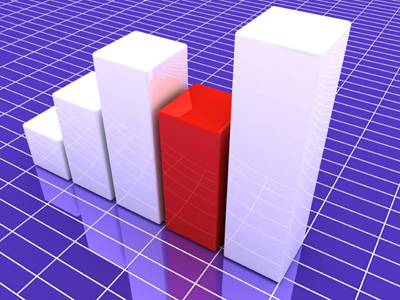
Ask the AI Tutor
Need help with Level 7-8 Algebra - Graphs 02? Ask our AI Tutor!
AI Tutor - Lucy
Connecting with Tutor...
Please wait while we establish connection

Graphs are useful for recording data.
Level 7-8 Algebra - Graphs 02
Straight-line graphs show patterns clearly. Learn gradient, intercepts, and coordinates to plot and read lines with confidence in KS3 Maths.
1 .
Which of these graphs would give you the most shallow gradient?
y = 3x - 1
y = 4x - 1
y = 5x - 1
y = 6x -1
The more times you multiply x, the steeper the gradient becomes
2 .
Which of these equations would give the steepest gradient?
y = x
y = 2x
y = 3x
y = 4x
In the correct answer, each movement of a unit along the x axis means a movement of 4 units up the y axis
3 .
Two coordinates of a line are as follows: (3, 21) and (2, 14). How might the line best be described?
It has a positive gradient
It has a negative gradient
It is horizontal
It is vertical
Lines that slope from the bottom left to the top right have a positive gradient. If you cannot imagine a line then plot it to see what it looks like
4 .
Two coordinates of a line are as follows: (2, 15) and (6, 10). How might the line best be described?
It has a positive gradient
It has a negative gradient
It is horizontal
It is vertical
It is worth remembering that you can have both positive and negative gradients in ANY quadrant
5 .
On a distance-time graph what does a line segment that is horizontal tell you?
The data is incorrect
The distance travelled was slowing down
The distance travelled was speeding up
There was no movement during the period
The line on the time axis continues but on the distance axis it has paused
6 .
Two coordinates of a line are as follows: (3, 12) and (2, 8). What is the equation?
y = 2x
y = 4x
y = 6x
y = 8x
If you plot the coordinates you will see that for every unit moved along the x axis, you move 4 units up the y axis. Working out an equation in this way has the grand name of the 'gradient-intercept' method
7 .
What is the mid point of the line (1, 9) (5, 15)
(1, 15)
(3, 12)
(6, 24)
(9, 15)
Take the first number in the first bracket and add it to the first number in the second bracket and divide the answer by two - gives you 3. Then do the same for the second numbers in the brackets and you will get 12
8 .
If a graph equation contains an exponent then what could you definitely say about the line?
It is very long
It is very short
It is straight
It is curved
Remember an exponent is the small number to the upper-right of another number. As soon as you see one of these in an equation you should expect a curve
9 .
Which of these equations would give the steepest gradient?
y = x
y = x + 1
y = x + 2
All the above are the same gradient
If all the lines were plotted on the same graph they would run parallel to each other
10 .
If a graph equation contains only the signs of plus, minus and equals then what could you definitely say about the line?
It is very long
It is very short
It is straight
It is curved
These are the simplest equations to plot
**Unlimited Quizzes Await You! 🚀**
Hey there, quiz champ! 🌟 You've already tackled today's free questions.
Ready for more?
Ready for more?
🔓 Unlock UNLIMITED Quizzes and challenge yourself every day. But that's
not all...
not all...
🔥 As a Subscriber you can join our thrilling "Daily Streak" against other
quizzers. Try to win a coveted spot on our Hall of Fame Page.
quizzers. Try to win a coveted spot on our Hall of Fame Page.
Don't miss out! Join us now and keep the fun rolling. 🎉
**Unlimited Quizzes Await You! 🚀**
Hey there, quiz champ! 🌟 You've already tackled today's free questions. Ready for more?
🔓 Unlock UNLIMITED Quizzes and challenge yourself every day. But that's not all...
🔥 As a Subscriber you can join our thrilling "Daily Streak" against other quizzers. Try to win a coveted spot on our Hall of Fame Page.
Don't miss out! Join us now and keep the fun rolling. 🎉






